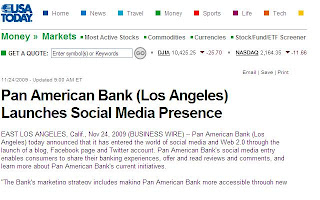I was recently paging through an industry magazine that featured an interview with a top ranking officer at Wells Fargo. This article was essentially a profile of a very accomplished Wells Fargo banker. As I read the article I was feeling good about this person and Wells Fargo Bank. Then it happened...
"Leading the COMMUNITY BANK [emphasis added]...blah blah blah." What?! Community bank? Wells Fargo? At that point I let out a loud "are you kidding me!?" (I figured it was loud because everyone outside my office was staring at me and wondering if I was upset with someone on the phone). "Nothing to see here folks. Get back to work."
Again, I have no problem with Wells Fargo. In fact, thoughout this whole mess I think they have managed their affairs better than most of the big guys. I love their marketing, their strategy and they seem to train well (two of my top performers are Wells Fargo alumni). I do, however, have a problem with a bank that calls itself a community bank that has total assets of $548 billion, $325 billion in deposits and 3,429 branches in 24 states (as of 9-30-09).
Back in October 1997, Steve Cocheo tried nailing down a definition in his ABA Banking Journal article, "Musing toward a definition of community banking." According to Steve, "community banking" can include mega-banks as well as local home-grown institutions. It all depends on your point of view and interpretation. As a small bank operator that is deeply vested in its community, I find that fact very disappointing.
In my perfect world community banks are not titles bestowed simply for doing good deeds in a community. To me and many of my community banker friends (as defined by me of course), community banks are just that, banks that serve a particular community. In my opinion, if your footprint spans the western United States you are not a "community bank." I don't care how you divide the empire. You're not a community bank. Plain and simple.
Over the past year and a half the banking industry has taken it on the chin. Surveys conducted during this period have shown a steady reduction in consumer trust of banks. With billions in bailouts, foreclosures at record levels and the whole regulatory reform mess, it is clear why consumers are not happy. While I will agree that some bankers took a few liberties with consumers, for the most part bankers and their banks were also brought along for the ride. In particular, community banks, who generally stayed away from the practices that created the whole mess.
The media and others are starting to recognize the role that community banks played or did not play. Not only did community banks generally not play a role in creating the banking debacle, they have generally been the only group lending during all the chaos. So when some regional bank comes along and calls itself a "community bank," I'm sorry, but I take offense. I respect you, but I take offense.
My problem is that community banking cannot be easily defined. For me, community banking means a bank that is focused on a particular "community." For example, I have three branches - two in East Los Angeles and one in Santa Ana. Those two communities are my focus. Nice and tight. When I can call the entire state of California my community I think I've gone beyond community banking. Perhaps a better guide is how much time your bank management spends on Wall Street versus Main Street.
I will be the first to admit that I don't know the right definition of what makes a community bank. But something I've learned as a banker is that your gut is usually right. And on this one my gut tells me that if you run a bank with branches in nearly half of all U.S. states, you're not a community bank.

What do you think? What does community bank mean? Let me know. I'm interested in hearing your opinion. Maybe I'm all wrong on this.














































